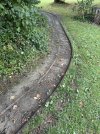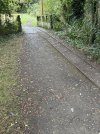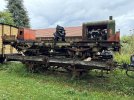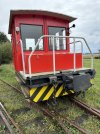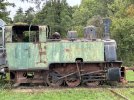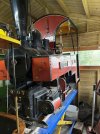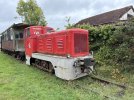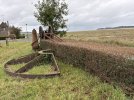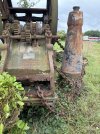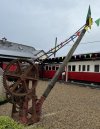You are using an out of date browser. It may not display this or other websites correctly.
You should upgrade or use an alternative browser.
You should upgrade or use an alternative browser.
Prototype A few photos from otherwhere
- Thread starter simond
- Start date
PhilH
Western Thunderer
An interesting collection, more here:
Chemin de Fer des Côtes du Nord, Bretagne
Chemin de Fer de la Baie de Saint-Brieuc – Site officiel de l'Association des Chemins de Fer des Côtes-du-Nord
Chemin de Fer des Côtes du Nord, Bretagne
Chemin de Fer de la Baie de Saint-Brieuc – Site officiel de l'Association des Chemins de Fer des Côtes-du-Nord
simond
Western Thunderer
I could have put money on you, Phil!
Spot on, of course.
The Briqueterie has a museum, which provides a significant amount of data on the railways of the region, and of the Engineer, Harel de la Noe, who was a bit of an all round star.
Anyone who is in the area wil an interest in CNC machining should perhaps visit the museum in St Brieuc, as there is a punch-card Jacquard loom on show - it all started there! (There’s one in Paisley too)
Last edited:
timbowales
Western Thunderer
Very intrigued by the lack of any form of counterweight on those cranes. They must have had a very low load limit or, instead, massive hidden foundations
Richard Gawler
Western Thunderer
Still nothing quite like the Peco one here!And another crane or four - and the flag is a clue!
PhilH
Western Thunderer
Lartigue Monorail | Experience a unique form of rail travel located in Listowel, Co. Kerry
A pity it just growls and doesn't chuff !
simond
Western Thunderer
Quite agree, but two boilers might have been just a wee bit more expensive. Apparently power now delivered by a Lister 3-cylinder engine through a hydraulic transmission. He didn’t offer to let me have a go, but “it’s quite easy to drive”.
it wasn’t unique, I believe. if I could just remember where the other one was…. And I understand there may be a kit for a 7mm one in the not too distant future. I don’t suppose they’ll sell many…
it wasn’t unique, I believe. if I could just remember where the other one was…. And I understand there may be a kit for a 7mm one in the not too distant future. I don’t suppose they’ll sell many…
Peter Insole
Western Thunderer
Never mind the cost, one pretend boiler is quite enough for me... and if I ever decided to raise a third rail above ground level in our garden, I rather imagine that any resulting problem with the natives would not just be a matter of obtaining planning consent?!
Pete.
Pete.
PhilH
Western Thunderer
According to the first link I gave in Post #71 the inventor Charles Lartigue built the first line across the desert in Algeria, about 90 Km in length. Apparently he got the idea from watching camels carrying large loads in panniers balanced either side of their backs.
The main (and probably only) advantage was that it was far cheaper to construct than a conventional railway.
Patrick Whitehouse has a chapter on the original line in his book 'Narrow Gauge Album' (Ian Allan 1957). I suppose it must be narrow gauge - with only one carrying rail it couldn't be any narrower ! A major problem was road crossings - major roads had a drawbridge over the track which had to be raised to allow the trains to pass and minor roads had a hinged section of track which could be opened like a gate to allow traffic to cross. In both cases signals were provided to warn trains when road vehicles had the right of way.
Little is known about the first locomotive which had two vertical boilers, probably used by Lartigue for demonstrating the system elsewhere. For the opening Hunslet built the three locomotives with horizontal boilers like the diesel replica, describing them as 0-3-2-0s with 7" x 12" cylinders and 2'-0" dia. wheels, delivered in 1887. The locos were scrapped after the line closed in 1925.
The main (and probably only) advantage was that it was far cheaper to construct than a conventional railway.
Patrick Whitehouse has a chapter on the original line in his book 'Narrow Gauge Album' (Ian Allan 1957). I suppose it must be narrow gauge - with only one carrying rail it couldn't be any narrower ! A major problem was road crossings - major roads had a drawbridge over the track which had to be raised to allow the trains to pass and minor roads had a hinged section of track which could be opened like a gate to allow traffic to cross. In both cases signals were provided to warn trains when road vehicles had the right of way.
Little is known about the first locomotive which had two vertical boilers, probably used by Lartigue for demonstrating the system elsewhere. For the opening Hunslet built the three locomotives with horizontal boilers like the diesel replica, describing them as 0-3-2-0s with 7" x 12" cylinders and 2'-0" dia. wheels, delivered in 1887. The locos were scrapped after the line closed in 1925.
simond
Western Thunderer
From what they told us at the museum, the other advantage of the Lartigue system is that, like camels, sand is not a problem.
Conventional railways have the unfortunate tendency to bury themselves in blown sand and apparently this is less of an issue with the mono/tri rail Lartigue system
The other thing that I picked up was that Lartigue was petitioning parliament to approve his design, and Listowel & Ballynunion were petitioning parliament for an act to enable a railway, my cynical mind thought that perhaps a mandarin in Whitehall saw an easy answer to get both of these petitioners off his desk in a single stroke of the pen…
Conventional railways have the unfortunate tendency to bury themselves in blown sand and apparently this is less of an issue with the mono/tri rail Lartigue system
The other thing that I picked up was that Lartigue was petitioning parliament to approve his design, and Listowel & Ballynunion were petitioning parliament for an act to enable a railway, my cynical mind thought that perhaps a mandarin in Whitehall saw an easy answer to get both of these petitioners off his desk in a single stroke of the pen…
James Spooner
Western Thunderer
The photos of the Listowel line remind me of a trip to India some years ago. Our party was invited to visit the National Railway Museum in Delhi (on our way to the Darjeeling Himalaya Railway). They kindly lit up the Patalia State Monorail engine (original, although not in the best of condition) and gave us a trip on the demonstration loop that had been laid in the museum grounds). It was a monorail in the broadest sense but relied upon a cantilevered arm out of the right hand side of each vehicle, at the end of which was a large iron or steel cartwheel, which ran on the road surface. A couple of the larger members of the party climbed on first and took seats on the far side of the carriage, which started to tilt over. A couple of museum staff leaned against the carriage and the aforementioned party members were encouraged politely to move to the other side as the view was better…
I have dug out a few photos of the PSM…
Nigel





I have dug out a few photos of the PSM…
Nigel





Arun Sharma
Western Thunderer
I note the bullet holes in the concrete tower.....A few more…
View attachment 164460View attachment 164461View attachment 164462View attachment 164463View attachment 164464View attachment 164465View attachment 164466View attachment 164467
I was wrong about the horizontal stripes on the semaphore, as you can see, it’s actually pierced with a series of vertical slots. Sorry for the awful photos!
The loco is a BoBo - it was coupled to two rather grotty UIC style coaches with very little paint, I’m not sure where it was going as there are no annunciations in the station. It was leaving before our train to Mostar.
The interior shot is from our train yesterday to Sarajevo.
simond
Western Thunderer
Yeah, quite an eye opener, Sniper alley in Mostar is still much as it was. There is still much distrust and pain remaining from the war.I note the bullet holes in the concrete tower.....
simond
Western Thunderer
I have just posted two adverts for some magazines and postcards which belonged to a pal who sadly died a few years back.
in amongst the postcards were a few photos, I have no idea where or when he took them, and indeed, I’m assuming they are his copyright (B Odom)

NG 0-6-0 (or is there a trailing truck in the gloom?) looks a bit French to me, but I suspect it isn’t.

At least this one has a label on it, Zillertalbahn.

unless my eyes deceive me, this is an 0-10-0 tender loco

and finally, a jackshaft 0-6-0 diesel. The station bears the name Jenbach, which is the visitor centre for the Zillertalbahn, so I guess they are all from there.
Enjoy!
Simon
in amongst the postcards were a few photos, I have no idea where or when he took them, and indeed, I’m assuming they are his copyright (B Odom)

NG 0-6-0 (or is there a trailing truck in the gloom?) looks a bit French to me, but I suspect it isn’t.

At least this one has a label on it, Zillertalbahn.

unless my eyes deceive me, this is an 0-10-0 tender loco

and finally, a jackshaft 0-6-0 diesel. The station bears the name Jenbach, which is the visitor centre for the Zillertalbahn, so I guess they are all from there.
Enjoy!
Simon
daifly
Western Thunderer
Loco in first photo in more recent times
Dave
Dave


